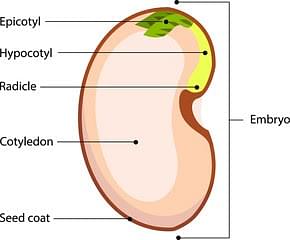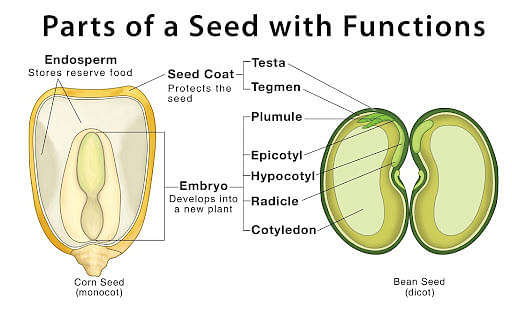A seed is the most basic component of every plant. After fertilisation, the ovules mature into seeds. A seed consists of two parts: a seed coat and an embryo.
- A radical and an embryonal axis or two cotyledons make up the embryo.
- A seed is located inside a fruit and when planted it grows into a new plant.
- Gymnosperm seeds are naked and open to the environment, whereas angiosperm seeds i.e. flowering plants have a protective structure called the fruit.
- In both cases, a male nucleus fertilises the egg inside the ovule through a pollen particle.
- This process in plants is known as pollination.
- The reproductive units of the plant are seeds.
- Seeds produce new plants when given good care and an appropriate habitat.
| Table of Content |
Key words: Seed, Plant, Endosperm, Cotyledon, Germination, Embryo, Ovule, Habitat, Pollination, Angiosperm, Fruit, Fertilisation
Read More About Fertilization in Plants
Definition of Seed
[Click Here for Sample Questions]
The matured and fertilised ovule, which includes an active embryo reserve food and protective coating, is referred to as a seed. Seeds are ripened ovules that contain an embryonic plant with sufficient reserve food for embryo development. Ovules develop into seeds after fertilisation.
Parts of a Seed
[Click Here for Sample Questions]
A seed is made up of four parts.
Seed coat
It is the seed's outer covering. It grows from the ovule's integuments. The seed coat is usually made up of two layers in most seeds.
- The outer layer is known as the testa, while the inner layer is known as the tegmen.
- Seeds produced by unitegmic ovules (ovules with only one integument) have a single layered seed coat.
- The seed coat's role is to safeguard the vulnerable embryo inside.
Cotyledons
Cotyledons assist a plant embryo to get the nourishment it needs to germinate and grow into a photosynthetic organism. They can also be a source of nutritional reserves or aid the embryo in metabolising nutrition stored elsewhere in the seed.

Parts of seed
Embryo
The embryo is a young or small plant that is encased within the seed coat. It grows out of a fertilised egg. The cotyledon and embryonal axis are two elements of the embryo.
- The cotyledonary node is the location on the embryonal axis where the cotyledons adhere.
- The epicotyl is the section of the embryonal axis that is directly above the cotyledonary node, and the plumule is located at the epicotyl's tip.
- The presence of one or more leaf primordia, or immature leaves, near the apex gives it a feathery appearance.
- The embryo is made up of the following components:
(a) Cotyledon
Monocots only have one cotyledon. In monocots, such as grasses, the scutellum is the equivalent structure.
(b) Radicle
A radicle is a structure found at the base of a seed that is covered by a root cap. Coleorhiza refers to the radical's undifferentiated protective sheath.
(c) Plumule
The embryonic leaves and the growing tip of the shoot are represented by the plumule. It is encased in a sheath known as the coleoptile.
Endosperm
Food is stored in the endosperm. Monocot seeds are generally endospermic, however few exceptions exist, such as orchids that are non-endospermic.
Read More on Plant Physiology
Types of Seed
[Click Here for Sample Questions]
Seed can be of various types;
Monocotyledonous seeds
Seeds having only one cotyledon are known as monocotyledonous seeds. Like, Orchids, Alisma, corn, rice, and other plants.
Dicotyledonous seeds
Seeds with two cotyledons are known as dicotyledonous seeds. Like, Gram, pea, bean, mustard, mango, and other legumes.

Types of Seed
Albuminous seeds (Endospermic)
Albuminous seeds are having an endosperm. Albuminous seeds have thin membrane cotyledons and endosperm that survives and feeds the seedling during its early growth. Castor, poppy, custard apple are some examples of it.
Exalbuminous seeds (non-endospermic)
Exalbuminous seeds are seeds that don’t have an endosperm. Food accumulates in the endosperm tissue of exalbuminous seeds early in development, but it is used by the growing embryo and mature seeds without endosperm. Cotyledons in such seeds store nourishment and become fat and meaty. Like, Gram, pea, bean, and other legumes.
Also Read
| Related Articles | ||
|---|---|---|
| Plant Roots | Plant Breeding | Reproduction in Plants |
| Classification of Plants | Plant Cell | Fundamental Unit of Life |
Formation of Seed
[Click Here for Sample Questions]
These are the processes that occur during seed formation:
- The fertilised egg (zygote) divides numerous times within the ovule to become an embryo.
- The ovule develops a strong sheath around it and is transformed into a seed that contains the infant plant over time.

Seed Formation Process
- The flower's ovary matures into a fruit with seeds inside.
- The sepals, petals, stamen, stigma, and style of the flower all dry out and fall off.
- Fruits preserve the seed. Some plants, such as mangoes and oranges, produce sweet, soft, juicy fruits, whilst others, such as peanuts and almonds, produce dry, hard fruits.
Seed Dispersal
[Click Here for Sample Questions]
Seed dispersal is a technique that contributes to the transfer of seeds to other locations in order to ensure that at least a few germinate and grow into adult plants.
- Embryonic plants are found in seeds.
- Their dispersal is extremely important in the distribution of plants across a wide range of geographical locations.
- Seeds must be correctly spaced in order to develop into healthy new plants and to avoid competition for the infant plants' basic needs.
Seed Germination
[Click Here for Sample Questions]
The Germination of a seed is the transformation of a seed into a young plant or seedling. The plant's seeds are frequently hard and dry when harvested. Seeds stay alive but inert for a long time at this stage. Seeds are said to be dormant at this stage.
- When the seed collects water, swells up, and breaks open through the seed coat, germination occurs.
- The water absorbed by the seed aids in the action of the enzymes.
- It breaks down the food stored in the cotyledons and renders it soluble.
- The radicle and plumule contained in the seed develop further as a result of this soluble nourishment.
- The seed's radicle develops first, forming the root, which extends down into the soil and begins to collect water and minerals.

Seed Germination Process
- The plumule then continues to develop upwards to produce the stalk. Green leaves appear when the stalk rises above the ground.
- Both the root and the shoot continue to grow. In the presence of sunlight, green sprout leaves begin to create their own food (photosynthesis).
- The seedling grows into a new plant gradually and eventually.
Read More: Seed Dormancy
Advantages of Seed
[Click Here for Sample Questions]
Production or development of seeds provides following benefits.
- Seed production is more reliable because blooming plants' reproductive activities are water-independent.
- Seeds have more adaptable dispersal techniques, this allows flowering plants to colonise new habitats and expand their range.
- Seeds have enough food reserves to last a long time.
- This provides nutrients to immature seedlings until they are capable of photosynthesis on their own.
- Seed coat protects the embryo.
- Seed storage necessitates dehydration and dormancy of mature seeds.
- As a result, seeds can be used to grow crops in the next season.
- Seeds have thus become the foundation of our agriculture.

Parts of a seed
Also Read:
| Related Articles | ||
|---|---|---|
| Fruit Definition | Seed Germination | Cell Biology |
Things to Remember
- The most essential aspect of seeds is that they can remain dormant for a long period before germinating if the right conditions are met.
- The cotyledonary node is the location on the embryonal axis where the cotyledons adhere.
- The epicotyl is the section of the embryonal axis that is directly above the cotyledonary node.
- The hilum is a scar on the seed coat that was used to bind the seed to the fruit.
- Seeds also aid in the spread of species to a variety of environments.
- Apart from plants, seeds are important to us in a variety of ways; for example, wheat and legumes are consumed by a large proportion of people.
- The ovules become seeds, and the ovary becomes fruit, all at the same time.
- The ovary wall develops into the pericarp, that is the fruit wall.
- The micropyle is a microscopic orifice on the seed that allows oxygen and water to exchange during the seed germination.
- Polyembryony refers to the existence of many embryos in a single seed.
- Each seed has a seed coat that protects it from the surroundings.
Sample Questions
Ques: What is the simple definition of Seed? (1 mark)
Ans: The seed is the plant's reproductive unit, consisting of a baby plant (embryo) and food (endosperm) for its growth & development.
Ques: What part of the flower produces a seed? (1 mark)
Ans: The ovule matures into a seed while the ovary develops into a fruit, and seeds are created after the fertilisation process in flower.
Ques: Which of the five phases of seed germination? (1 mark)
Ans: Water absorption, respiration, the effect of light on seed germination, the use of reserve food and growth regulators, and the development of the embryo axis into a seedling are the five stages of seed germination.
Ques: Write down two advantages of a seed (2 marks)
Ans: Seeds have more adaptable dispersal techniques, this allows flowering plants to colonise new habitats and expand their range. Seeds have enough food reserves to last a long time. This provides nutrients to immature seedlings until they are capable of photosynthesis on their own. Seed coat protects the embryo.
Ques: What is the purpose of the hilum in a seed? (1 mark)
Ans: Hilum allows water into the embryo prior to active germination. The stalk that linked the ovule to the ovary wall before it became a seed leaves a scar called a hilum.
Ques: What are different types of seeds? (1 mark)
Ans: Seeds can be classified into monocotyledonous seeds and dicotyledonous seeds.
Ques: What is the outer covering of seed? (2 marks)
Ans: The seed coat is the outer covering of a seed. Seed coatings protect the embryo from harm as well as drying out. Beans have thin and delicate seed coats whereas locust and coconut seeds have thick or hard seed coats.
Ques: Write about different parts of seed. (4 marks)
Ans: Seeds involve various parts such as seed coat, cotyledons, embyo and endosperm.
Seed coat- an outer covering of seed that protects the seed. The seed coat is made up of two layers in most seeds.The outer layer is known as the testa,and the inner layer is the tegmen.
Cotyledons-It assists a plant embryo to get the nourishment it needs for germination and growth. It classifies the seed in two types; monocotyledon and dicotyledons.
Embryo- It forms after fertilization. It has 3 parts; Cotyledons, Radicle and plumule.
Endosperm-It is a food storing comonent of seed. Monocotyledon seeds are geneally endospermic.
For Latest Updates on Upcoming Board Exams, Click Here:https://t.me/class_10_12_board_updates
Also Read:






Comments